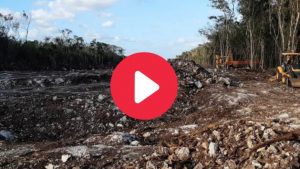
The Mayan Train (TM), run by the government’s National Tourism Development Fund (Fonatur), threatens the Mayan Jungle, the second largest in Latin America after the Amazon rainforest. its ecosystems and indigenous communities, as well as underground caves and cenotes – freshwater sinkholes resulting from the collapse of limestone bedrock that exposes groundwater
By Emilio Godoy
PLAYA DEL CARMEN, Mexico, Jan 24 2023 – The Mayan Train (TM), run by the government’s National Tourism Development Fund (Fonatur), threatens the Mayan Jungle, the second largest in Latin America after the Amazon rainforest. its ecosystems and indigenous communities, as well as underground caves and cenotes – freshwater sinkholes resulting from the collapse of limestone bedrock that exposes groundwater.
The most ambitious megaproject of the government of President Andrés Manuel López Obrador involves at least 1,681 hectares and the felling of 300,000 trees, according to the original environmental impact study, with an investment that has so far run up to around 15 billion dollars, 70 percent of the initially planned cost.
The plan is for the TM, with 21 stations and 14 stops on seven routes, to start running at the end of 2023 through 78 municipalities in the southern and southeastern states of Campeche, Quintana Roo, Tabasco and Yucatán, home to a combined total of 11.1 million people.
In Quintana Roo there are at least 105 flooded caves over 1,500 meters in length and 408 underwater caves. The porous karst soil of the peninsula represents a threat to the megaproject, which has forced the authorities to change the layout.
In addition, between Playa del Carmen and Tulum – 61 km apart in the south of Quintana Roo – there are at least 13 cenotes.
The Mayan Train, which covers four aquifers and 49 bodies of water along its route, includes a station in Playa del Carmen and another in Tulum, in Section 5.
Fabiola Sánchez, an activist with the non-governmental organization Voces Unidas (United Voices) de Puerto Morelos, talks about the potential impact of the railway in the municipality of Puerto Morelos, in Quintana Roo.
The concern of environmentalists stems from the 2020-2030 Urban Development Program, which they accuse of favoring hotel and real estate interests, to the detriment of citizen participation and sustainable planning, and of favoring the creation of the railway.
Deforestation and urban expansion can result in waters with more sediment in the reefs off Puerto Morelos, greater generation of solid and liquid waste, leaching, and more pollution, that would put even more pressure on an ecosystem that is already disturbed by human activities.
The trains will transport thousands of tourists and cargo, such as transgenic soybeans, palm oil and pork, major agricultural products in the region.
The Mexican government promotes the megaproject as an engine for social development that would create jobs, boost tourism beyond the traditional sites and bolster the regional economy.